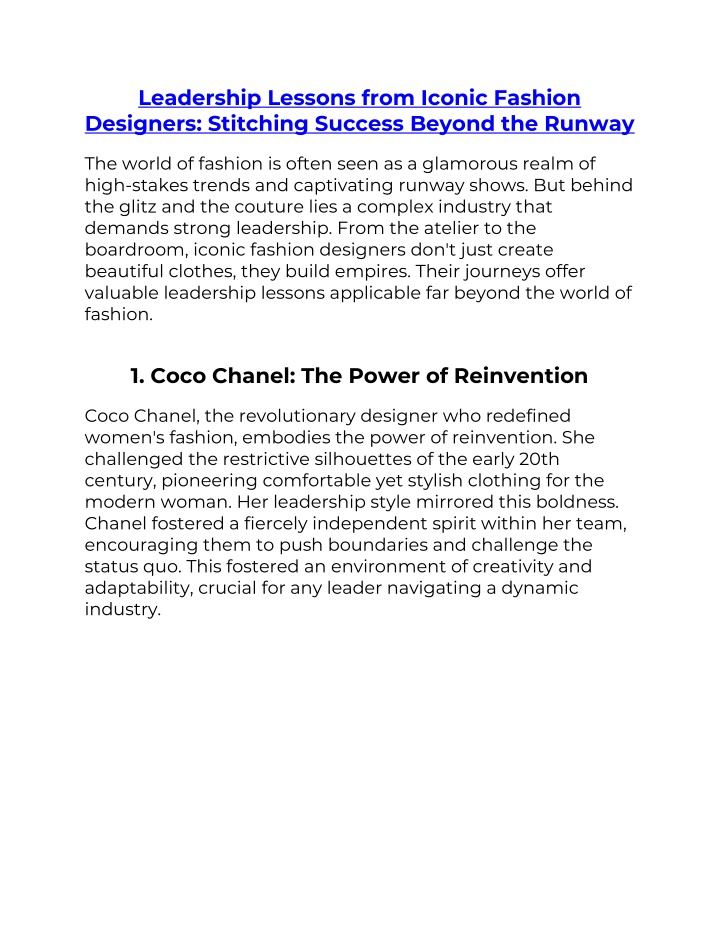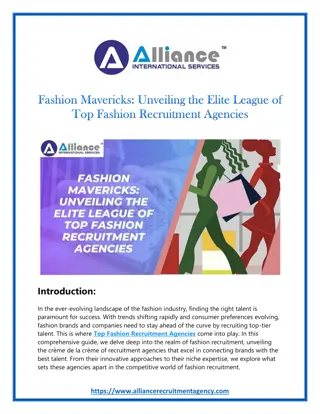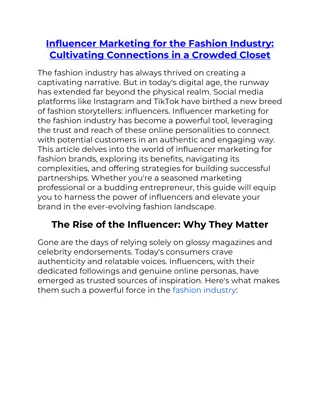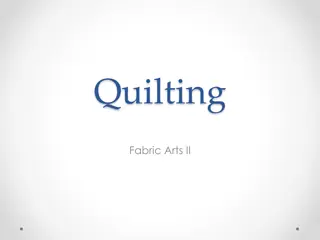
Leadership Lessons from Iconic Fashion Designers- Stitching Success Beyond the Runway
The world of fashion is often seen as a glamorous realm of high-stakes trends and captivating runway shows. But behind the glitz and the couture lies a complex industry that demands strong leadership. From the atelier to the boardroom, iconic fashion
Download Presentation

Please find below an Image/Link to download the presentation.
The content on the website is provided AS IS for your information and personal use only. It may not be sold, licensed, or shared on other websites without obtaining consent from the author. If you encounter any issues during the download, it is possible that the publisher has removed the file from their server.
You are allowed to download the files provided on this website for personal or commercial use, subject to the condition that they are used lawfully. All files are the property of their respective owners.
The content on the website is provided AS IS for your information and personal use only. It may not be sold, licensed, or shared on other websites without obtaining consent from the author.
E N D
Presentation Transcript
Leadership Lessons from Iconic Fashion Designers: Stitching Success Beyond the Runway The world of fashion is often seen as a glamorous realm of high-stakes trends and captivating runway shows. But behind the glitz and the couture lies a complex industry that demands strong leadership. From the atelier to the boardroom, iconic fashion designers don't just create beautiful clothes, they build empires. Their journeys offer valuable leadership lessons applicable far beyond the world of fashion. 1. Coco Chanel: The Power of Reinvention Coco Chanel, the revolutionary designer who redefined women's fashion, embodies the power of reinvention. She challenged the restrictive silhouettes of the early 20th century, pioneering comfortable yet stylish clothing for the modern woman. Her leadership style mirrored this boldness. Chanel fostered a fiercely independent spirit within her team, encouraging them to push boundaries and challenge the status quo. This fostered an environment of creativity and adaptability, crucial for any leader navigating a dynamic industry.
Lesson Learned: Leaders must be willing to reinvent themselves and their vision. Embrace change, encourage calculated risks within your team, and don't be afraid to disrupt the status quo. 2. Ralph Lauren: Building a Cohesive Brand Identity Ralph Lauren stands as a testament to the power of a strong brand identity. He didn't just design clothes; he crafted a lifestyle. From preppy sportswear to classic Americana tailoring, Lauren's designs evoke a sense of timeless elegance and effortless sophistication. His leadership style reflects this cohesiveness. He builds a team that understands the core values of the brand and ensures consistency across all aspects of the business, from design to marketing.
Lesson Learned: Leaders must cultivate a clear and consistent brand identity that permeates every aspect of their organization. Ensure your team understands and embodies your core values. 3. Donatella Versace: The Art of Collaboration Donatella Versace, the creative force behind the iconic Italian fashion house, exemplifies the importance of collaboration. After the tragic loss of her brother Gianni, Donatella took the helm, leveraging her expertise in public relations and fashion sense to build upon his legacy. She fostered strong relationships with photographers, stylists, and celebrities, creating a synergy that propelled the Versace brand to even greater heights. Lesson Learned: Leaders must be collaborative, understanding that success rarely comes alone. Build strong relationships with your team, leverage diverse skillsets, and foster a culture of open communication. 4. Rei Kawakubo: Embracing Disruption Rei Kawakubo, the founder of Comme des Gar ons, is a champion of disruption. Her avant-garde designs challenge traditional notions of beauty and wearability, pushing the boundaries of fashion. This translates to a leadership style that prioritizes innovation and a willingness to take calculated risks. She encourages her team to think outside the box and experiment with unconventional approaches. Lesson Learned: Leaders must be unafraid to disrupt the norm. Encourage creative exploration within your team and embrace innovative ideas, even if they seem unconventional at first.
5. Stella McCartney: Championing Sustainability Stella McCartney, the daughter of music legend Paul McCartney, is a pioneer in sustainable fashion. She has challenged the industry's often wasteful practices, using recycled materials and eco-conscious production methods. Her leadership style emphasizes social responsibility and ethical practices. McCartney inspires her team to find innovative solutions that benefit both fashion and the environment. Lesson Learned: Leaders must be purpose-driven. Integrate social responsibility and ethical practices into your core values, inspiring your team to contribute to a greater good. 6. Karl Lagerfeld: The Visionary Leader Karl Lagerfeld, the enigmatic creative director of Chanel for over three decades, embodies the power of a strong vision. He reinvented the iconic brand, injecting it with a youthful spirit while staying true to its core essence. His leadership style was demanding yet inspiring. He pushed his team to excel, setting clear expectations and goals while providing the creative freedom to translate his vision into reality. Lesson Learned: Leaders must have a clear and compelling vision. Articulate your goals effectively, inspire your team to achieve them, and provide the resources and autonomy they need to succeed. 7. Tom Ford: Building a Global Brand Tom Ford, the designer known for his luxurious and sensual aesthetic, exemplifies the importance of building a global brand. He revitalized Gucci in the 1990s and launched his own
successful label, leveraging his understanding of diverse tastes and markets. His leadership style revolves around strategic planning and a keen understanding of global trends. He carefully curates his brand image, ensuring international appeal while maintaining a strong sense of identity. Lesson Learned: Leaders must think globally. Be aware of diverse markets and trends, and adapt your strategies to reach a wider audience without compromising your brand's core values. These iconic fashion designers offer a wealth of leadership lessons applicable in any field. From reinvention and collaboration Building Your Team: Lessons from Fashion's A- Team
The leadership journeys of iconic designers extend beyond personal vision. They all understand the importance of building a strong, cohesive team. Here's how fashion translates to effective team-building strategies: Diversity is Strength: Miuccia Prada, the powerhouse behind the Prada brand, is known for her eclectic designs that blend classic tailoring with unexpected elements. This reflects in her team building she values diversity of thought and experience. Similarly, learn from Prada and cultivate a team with varied backgrounds and perspectives. Mentorship Matters: Christian Dior, the iconic French designer, nurtured young talent like Yves Saint Laurent. This commitment to mentorship fostered a generation of successful designers. Emulate Dior by mentoring within your team. Invest in your people's growth, providing opportunities for professional development and knowledge sharing. Empowerment Over Micromanagement: Giorgio Armani, the king of Italian tailoring, is known for his elegant and minimalist designs. His leadership style mirrors this he empowers his team with clear expectations but allows for creative freedom. Don't micromanage trust your team to deliver with the necessary resources and support. Celebrate Success: Marc Jacobs, the flamboyant designer known for his bold and playful designs, is a master of creating buzz. He understands the importance of celebrating success with his team. Acknowledge and reward achievements, fostering a positive and motivated work environment.
Beyond the Runway: Fashion's Impact on Leadership The influence of fashion on leadership extends beyond specific examples. Here are some broader takeaways: Presentation Matters: Fashion designers understand the power of a well-curated image. Leaders should too. Dress professionally for your industry and role, and cultivate a personal brand that reflects your values. First Impressions Count: From a captivating runway show to a polished presentation, fashion thrives on first impressions. Leaders must be able to make a positive impact quickly, whether it's a meeting with a client or an elevator pitch to a potential investor. Confidence is Key: The best runway models exude confidence. Projecting confidence is essential for
leadership too. Communicate clearly, believe in your vision, and inspire those around you with your presence. Adaptability is Essential: The fashion industry is constantly evolving. Leaders must be able to adapt to changing circumstances and market trends. Be flexible, embrace change, and be willing to adjust your strategies when necessary. Conclusion: Stitching Together Your Leadership Style The world of fashion offers a vibrant tapestry of leadership lessons. From reinvention and collaboration to building strong teams and celebrating success, these insights are valuable for leaders in any industry. As you navigate your own leadership journey, remember a strong vision, a commitment to your team, and the willingness to adapt are the threads that will stitch together your success. So, take inspiration from the fashion icons, and step onto the runway of leadership with confidence and a touch of style.




















